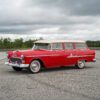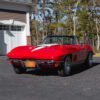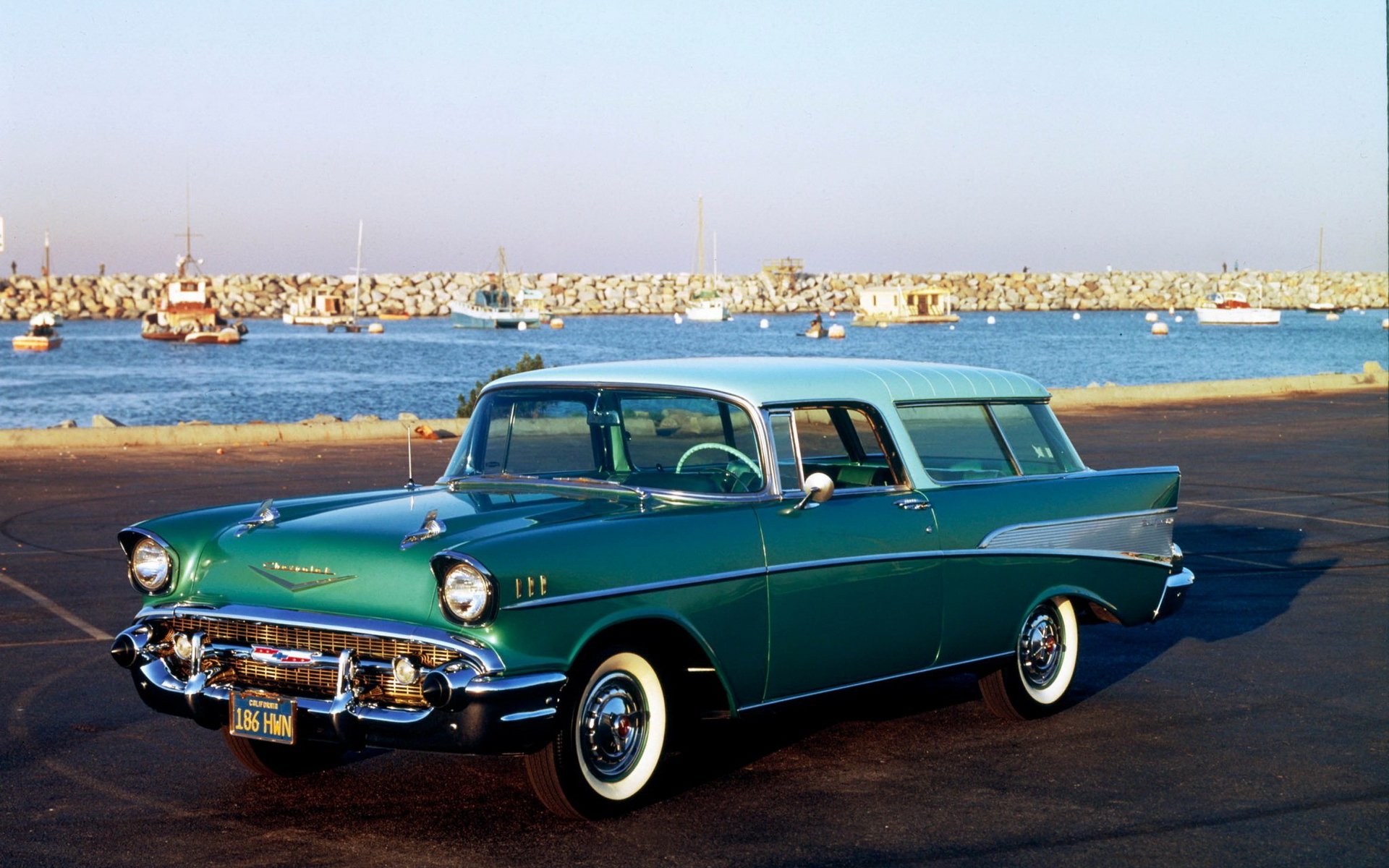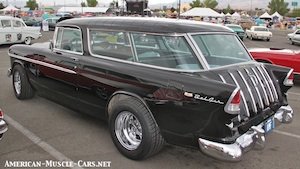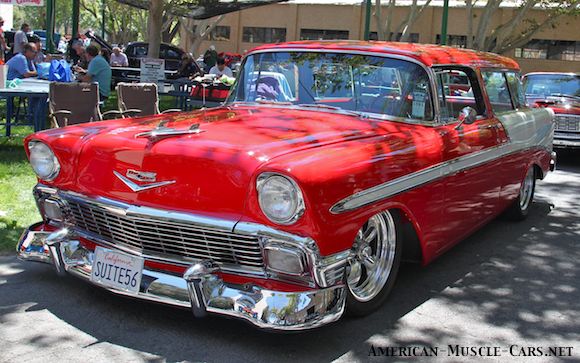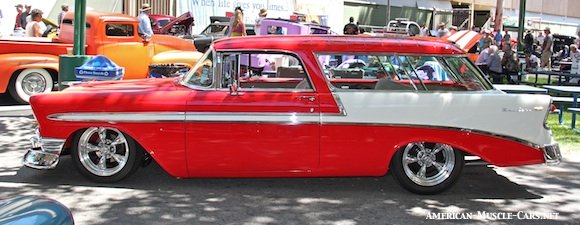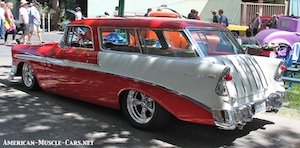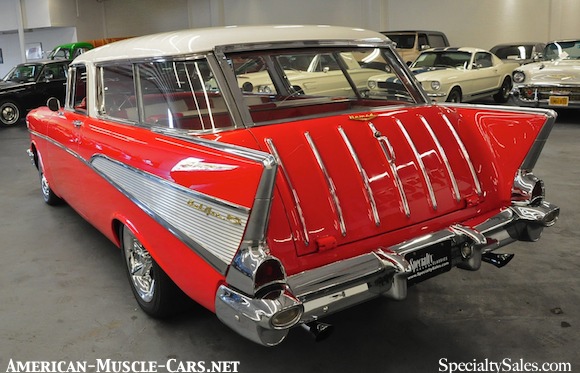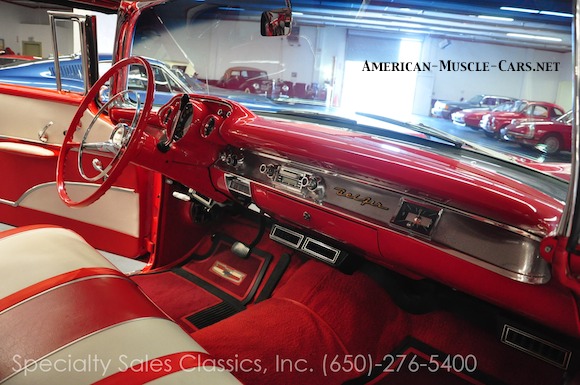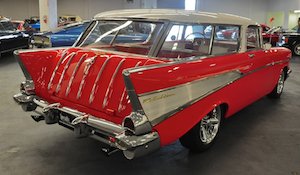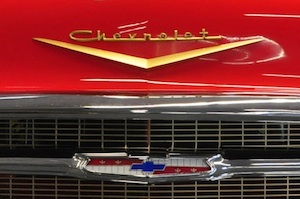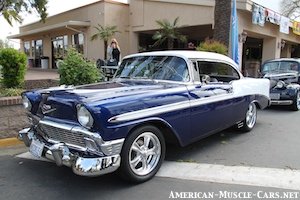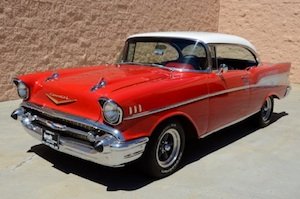Chevrolet Nomad
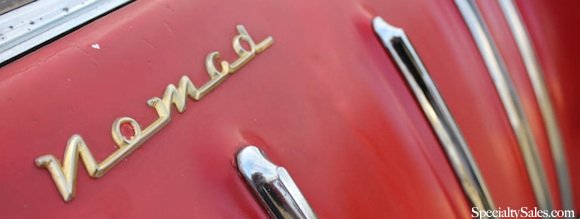
CHEVROLET NOMAD ORIGINS
The story of the Nomad begins with the birth of the Corvette. The original Corvette show car, called the “Waldorf Corvette”, so named because it was shown at the Waldorf Astoria Hotel in Manhattan. It was the familiar 1953 to 1955 Corvette body with a roof and greenhouse of the 1955-57 Nomad. It was wildly successful, but when GM green-lighted the Corvette, it was as a 2-seat convertible sports car, with typical removable rag top, not a station wagon. So, the Nomad was laid to rest for a couple of more years, only to be resurrected just as the radically new 1955 Chevys were being conceived. This time, the Nomad would be built from a normal full-sized car, and would be a distinctive, sporty 2-door wagon at the very top of the Chevrolet lineup. All Nomads were top-of-the-line Bel Airs, and were in fact called “Bel Air Nomads” in Chevy literature. They were also priced top-of-the-line, more than any other model except the Corvette. Of course, this hurt sales. Nomads never sold in big numbers and the price was certainly part of it. But its blend of station wagon practicality and sporty intentions was lost on most people. In its best year, 1955, Chevy managed to sell only 8,365 Nomads. They only made the iconic 2-door Nomads in 1955, 1956 and 1957. Chevy continued to resurrect the name from time to time, attached to some station wagon or another.
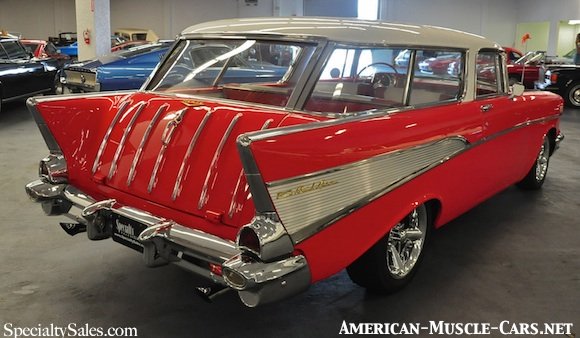
CHEVROLET NOMAD UNIQUE FEATURES
While every Chevrolet built at the time (except the Corvette) shared the same sheetmetal from the cowl forward, from there on out, the Nomad was unique. Not quite a traditional Station Wagon, even when compared to the 2-door Station Wagons of the time, it was really more of a ”Sport Wagon”. To begin with, it had frameless door windows, like a convertible or a pillarless hardtop. Then, it had the sloped B-pillars with just the right angle forward. Next were the sliding rear quarter windows, fairly unique then and now. Then the tailgate was set at an extreme angle also, giving it a racy look, especially when compared to the nearly-vertical tailgates of standard wagons. The tailgate also had seven very distinctive vertical chrome spears. And the roof had nine rib pressed into the sheetmetal that ran side to side from one side window to the other. The 1955s had chrome trim that was different from any other Chevy every produced, 1955 or otherwise. Instead of the normal busy array of Bel Air chrome trim, the ’55 Nomad made due with a Nomad-specific chrome eyebrow over the headlight that spilled back into one simple chrome spear that ran back over the fender and most of the door, ending near the back of the door. It was elegantly clean and simple, and despite the enormous side panels on a ’55 Chevy wagon of any type, it looked just right. Another unique feature just to ’55 Nomads were the rear fender openings. If you look at any other 1955 Chevy, you will see that their rear fender cover the top half of the rear wheel and tire, they’re semi-skirted. And all the 1956 and 1957 Chevys, Nomad or otherwise, have teardrop-shaped rear fenders that also cover nearly the top half of the rear wheel. The 1955 Nomad however, has a full rear wheel opening, perfectly formed and in balance. All Tri-Five Chevys should have had these rear fenders. They allowed for much larger rear wheels and tires with the typical clearance problems. I know, I had a hot rod ’55 Nomad.
1955 Chevrolet NOMAD
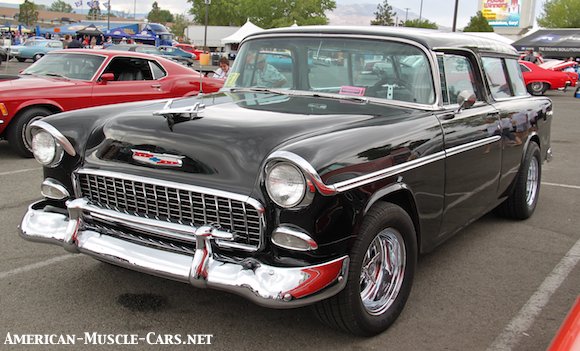
ABOVE: This 1955 Chevy Nomad has all the classic good looks of the all-new 1955 Chevrolet passenger car line, with the premium trim of the Bel Air. It was already a great-looking car, but the addition of the unique Nomad greenhouse made it even better. This one has the optional bumper guard.

ABOVE: One unique feature of the 1955 Chevy Nomad is its rear wheel openings. They’re unique among Nomads, unique among other 1955 Chevys, and unique among all Tri-Five Chevys. Where the Nomad has full, nicely-shaped wheelwells that easily accommodate larger tires, every other 1955 Chevy passenger car had squared-off rear fenders that half-cover the rear tire, making it impossible to run a wider tire. Another feature that was just as unique to the 1955 Chevy Nomad was the unusual chrome trim running from the headlight eyebrow down the sides, ending at the rear cutline of the doors. It’s the only 1955 model Chevrolet to have it. It was understated by the standard of the day, especially for a Bel Air.
I used to own a black 1955 Chevy Nomad that looked very much like this one, back in the early 1970s, when it was the fastest car in my hometown for a few years. Ah, those were the days.
BELOW: This is a great angle to view what truly makes Tri-Five Nomads unique. First off, they have 2 doors, but they’re not like a normal 2-door station wagon with roll-up back windows and squared-up styling. The nomad had very swoopy styling, with a slanted B, C and D pillar, giving it a very rakish look. It also had sliding rear-side windows instead of more conventional roll-ups like a normal 2-door wagon would have. The Nomad continued the forward-leaning theme into the tailgate which lays forward at quite an angle. It bears one of the Nomad’s most noticeable design cues, the seven vertical chrome spears on the tailgate. Another was the nine lines that cross the roof from side-to-side.

MY OWN PERSONAL 1955 CHEVY NOMAD
I used to own a black 1955 Chevy Nomad that looked very much like this one, back in the early 1970s, when it was the fastest car in my hometown for a few years. It had a built fuel-injected 327 out of a ’65 Corvette backed up by a Super T-10 and 3.70:1 Posi. The Rochester mechanical fuel injection worked great most of the time. I had very little trouble with it. It was wicked-fast for the times. Ah, those were the days.
1955 BEL AIR NOMAD-page
First year for this legendary car, it established the pattern for every Tri-Five Nomad to follow. With one unique difference: those wonderful rear wheel wells.
1956 Chevrolet NOMAD
1956 CHEVROLET NOMAD STYLING CUES
The classic Nomad greenhouse never changed year-to-year, but was grafted onto the body shell of each successive year, 1955 through 1957. Of course, this meant the 1956 Nomad would be styled similarly with the rest of the 1956 Chevrolet lineup. Note the sweeping shape of the rear wheel openings. While done purely for stylistic reasons, it proved to be a big problem for anyone wanting to mount wider tires on the back. For the 1955 Nomad, Chevy opted to make that Nomad’s rear wheel openings unique among all Tri-Five Chevy’s, which would have been a smart thing to carry through all 3 model years. Instead, that sweeping chrome spear running front-to-back on this 1956 Bel Air (all Nomads were Bel Airs) determined the shape of the rear fender.

1956 BEL AIR NOMAD-page
With more eye-popping Pictures, Specs, History & more.
1957 Chevrolet NOMAD

1957 CHEVROLET NOMAD IS OVER THE TOP!
After 2 highly successful years (1955 and 1956) Chevrolet planned to come out with a radically-new design for 1957. So radical that it took too long to engineer it, so it got pushed back a year, and became the 1958 Impala. So, with little time to spare, they did a total restyle of the 1956 Chevy, adding a whole new skin, completely new interior, much more chrome everywhere, and a new engine: the 283 small block V8. Included in the engine lineup for the first time ever in a mass-produced car at the time, was a Rochester mechanical fuel injection system that allowed the 283 to make 283 horsepower, a first-time-ever-for-a-production-car record of one-horsepower-per-cubic-inch. (For those of you who are modern car guys and/or know the metric system, that works out to a specific output of 61 horsepower-per-liter. Certainly not stellar by today’s standards, but ground-breaking for the times.) Despite all the performance boost and all the added glitz and glamour, the 1957 Chevy overall sold fewer units (1,380,352) than they did in 1956 (1,571,352) or 1955 (1,713,885). Nomad sales were also down. While never a big seller due to its high cost, relatively few were built. In its introductory year of 1955, also it’s biggest year, only 8.386 Nomads were built. In 1956, Nomad production slid to 7,886 units, and in 1957 eroded further to just 6,103 units. No wonder Chevy pulled the plug on this stand-alone 2-door sport wagon, and replaced it with a top-line 4-door wagon in the Biscayne lineup for 1958. But, this all contributes to their relative rarity, although I see tons of them at virtually every car show I go to these days.
Visit out page dedicated to the
1957 BEL AIR NOMAD-page
1957 was the final year for the classic 2-door Chevy Nomad. And it went out with a bang, with the 1957 Bel Air’s huge fins and opulent brightwork.
VIDEO: “Anatomy of a Nomad”
A video walk-around of a ’55 Nomad and a ’55 Chevy 2-door wagon, pointing out the differences & what makes Nomads unique.
Large format version for Laptops
Pontiac Safari: the ‘Sister-Car’ of the Nomad
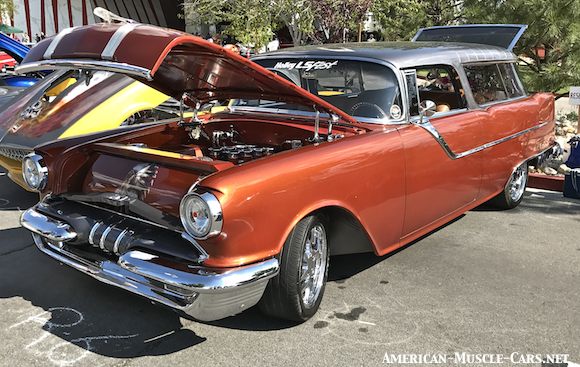
PONTIAC SAFARI – LIGHTNING DOESN’T STRIKE TWICE
The “Greenhouse” on a car is the upper structure of the body that includes the windshield and frame, the roof, and all the windows. It’s a very expensive piece to engineer, tool up for and produce, and so car manufacturers try to use them on as many models as possible to help offset the high cost. The Camaro and Firebird are good examples of this. So, GM decided to spin another model off of the Nomad’s big greenhouse, and bestowed it on Pontiac. They dropped the Nomad’s greenhouse onto a 1955 Pontiac Star Chief and called it the “Safari”. It was pretty ugly, and didn’t sell nearly as well as the slow-selling Nomad, at only 3,760 for 1955 against the Nomad’s 8,386. Like the Nomad, after the Tri-Five-years they turned their 2-door sport wagon into their premium 4-door wagon in 1958.
Chevrolet Nomad YEAR-BY-YEAR
1955 BEL AIR NOMAD
Introductory year for this legendary car. The ’55 set the pattern for every 2-door Nomad to follow.
1956 NOMAD
The legend continues. Classic 1956 Bel Air looks with the sporty Nomad greenhouse on top.
1957 BEL AIR NOMAD
Big fins come to the Nomad. Final year of the classic 2-door sport wagon. The name returns in ’58 on the top-line 4-door station wagon.
Other TRI-FIVE CHEVYS
The 1955, 1956 and 1957 Chevrolets stand out as a major watershed in automotive history & development. They changed the world and the market. They brought style & performance to the masses. Their popularity has never wained.
The car that changed it all. Lots of innovations, and racy new styling made it a major hit. And that new small block V8 was nothing sort of brilliant.
Mostly carryover from ’55, but lots of improvements were made. Completely restyled, it begins the trend toward “longer-lower-wider” with its full-width front grille.
Third & perhaps best year of the Tri-Five. 265 V8 gets punched out to 283 & with Fuel Injection becomes the first production car to achieve one horsepower per cubic inch.


